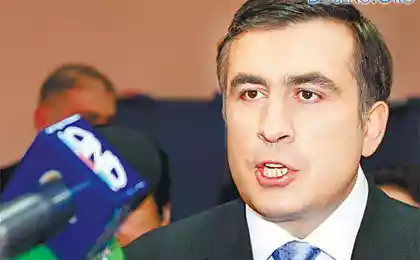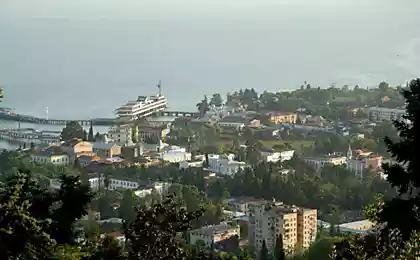1061
The resort of Abkhazia (35 photos)
More about 20 years ago, when the Soviet Union existed, Abkhazia honored paradise, and come here to rest for a Soviet citizen was a big success. But then the Soviet Union collapsed, there was an ethnic Georgian-Abkhaz conflict, war, economic blockade and for many years thereafter, to the former elite resorts dared to ride very few. Over time here was coming more and more people attracted small at that time prices and memories, his or her parents, a former resort glory of this place. For several years I was listening impressions from friends, reading articles on the web or remembering my mother's and grandmother's stories about the local beauty, wanted to go here. And so this year failed to materialize ideas and, finally, to see what this is all the former Soviet paradise on earth - the country of Abkhazia.

Abkhazian-Caucasian coloring manifested as soon as got into a taxi after the border. Kerf in the hollow volume of lezginka frayed wheezing speakers, the driver pulled up and, feels to have forgotten that there is a brake pedal. What is there to speak about overtaking through a continuous separating closed front for visibility turns, a real brave do not even think about such trifles as the oncoming traffic that can come from behind this turn right in the forehead ...
And then, finally, Gagra. Entrance to the city, decorated with a little depressing - abandoned shopping center.
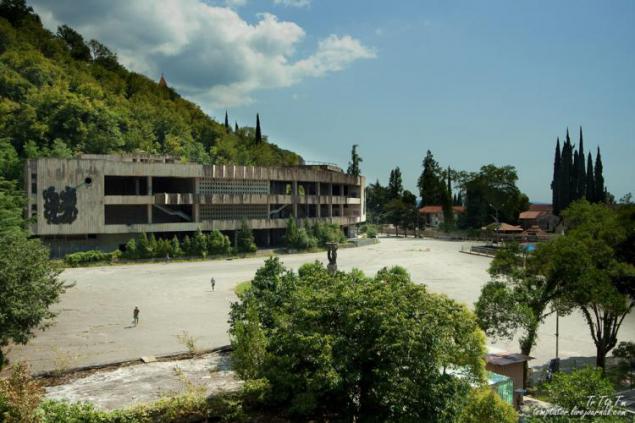
The area in front of him - Gagarin Square fountain adorns inactive "Three Graces". A few days after the frame on the lawn around the fountain priberut trash, mow the grass and the bushes give a spherical shape.

Here he writes tourist guide "the Black Sea coast of the Caucasus" 1980 edition: "Gagra - one of the most beautiful resorts in the Black Sea coast. Pressed to the sea mountain range, it is situated on the shore of the bay mirror. Gopami protected from the cold continental winds and at the same time open by the warm sea, Gagra on its climate conditions - one of the best holiday destinations in the Soviet Union. This is the warmest and driest place on the Black Sea coast of the Caucasus. The average annual temperature is + 15, 2 degrees and rainfall is 1300 mm per year. Swim here begins in May and ends in late autumn, in November, when most of the country the mercury thermometer drops below zero, and in some places already raging snowstorm. The best time of the year - August, September, October. In these months, the temperature of the sea water varies from 18 to 28 degrees. »
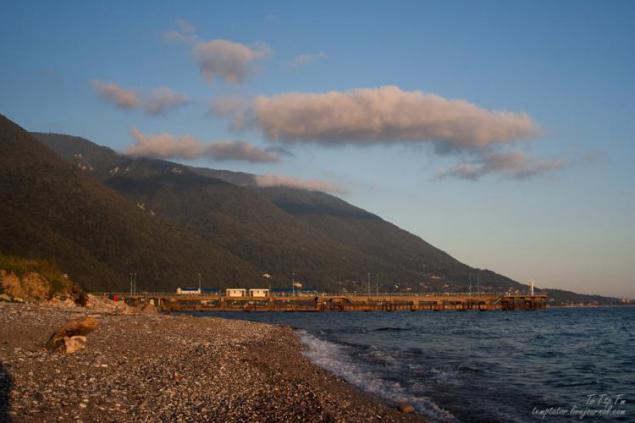
Nature is without a doubt excellent. Mountains, clouds and catchy ranges down to the sea, coast, drowning in subtropical vegetation ... But the sad look on this background looted ruins ...
Right behind Piazza Gagarin, on the bridge, located an abandoned railway station Abaata. The station is named is located near the Abkhaz fortress built in the IV-V centuries. In those days the fortress is a powerful reinforcement. Abaata considered one of the oldest fortifications on the Black Sea coast. Now the fortress remained only a small fence, inside which is a small museum, temple, restaurant, hotel and boarding house abandoned "Zhoekvara" - photo in the header.



For station Abaata begins Zhoekvarskoe Gorge, climb to above which can be passing out Russian volunteers. There are several very battered apartment buildings, dilapidated building, reminiscent of DC and dozens of private houses.

Zhoekvarskoe Valley since time immemorial served as a road leading to the North Caucasus and binding Abkhaz and Circassian tribes. Abaata fortress, located near the mouth of the river Zhoekvara, in fact, covered this way.

Now Gorge - a great place for a walk on a hot afternoon. Only ten to fifteen minute walk and the road dives into the cool shade of boxwood trees. Cool shade, moss covering the trunks and shreds hanging from the branches - a real troll forest.

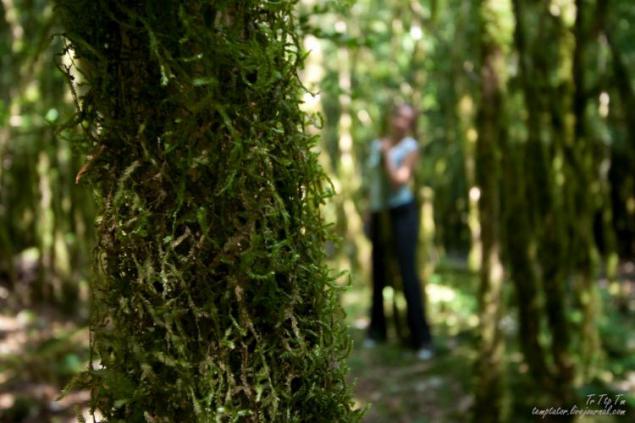
Just above the gorge on the river Zhoekvara there are several small picturesque waterfalls. You can get here on foot, but the road is gradually turning into a rather dirty and broken trail horse's hoof. We decided not to get dirty and ride on horseback to the waterfalls.
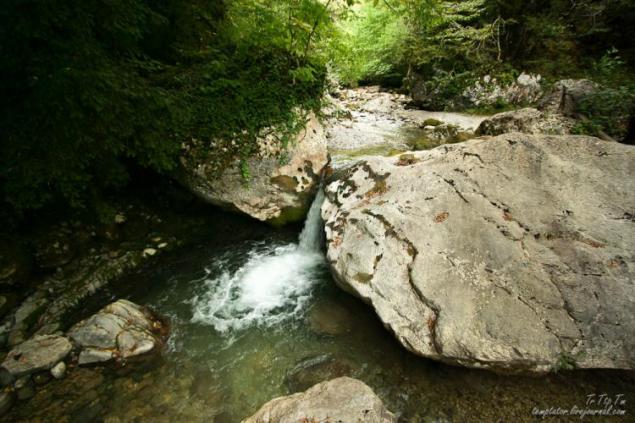

Settlement on the site of Gagra existed for a long time. In the II century before NE there was a Greek colony Triglia. In the beginning of our era Greeks were replaced by the Romans, who built a fortress here Nitika, the site of which was later built a fortress Abaata.
For the first time on the maps settlement appears at the beginning of the XIV century. In 1308 it under znazvaniem Kakar inflicted on his card Italian Pietro Visconti. In 1810, the Principality of Abkhazia became part of the Russian Empire, but the territory of Gagra was 20 years out of Russian influence. In 1830, the Russian garrison fortress occupies Abaata. These sites are then considered "the coffin for the Russian soldier." The fortress has been cut off from the outside world, malaria decimated the soldiers, were killed in large numbers and they are the bullets highlanders.
At the end of the XIX century these lands became eligible Athos monastery monks, but they beat a strong opponent - a relative of the king, Prince AP Oldenburg who wanted to organize a grand resort here. At the heart of the Prince of Oldenburg on development of Gagra was the desire to reduce the leakage of money that Russian know spender on foreign resorts, he wanted to create here "Russian Nice." Was founded Seaside Park, where excellent accustomed subtropical plants from different corners of the Earth, erected the building of the hotel and restaurant. The most grandiose construction became the Prince Castle, built in 1904.
Now the castle of the Prince of Oldenburg, as well as many other buildings in Gagra, produces a painful impression:

The castle was built by the architect IK Lyutseranskogo in modern style with a roof covered with red tiles. fireplace, balcony and tower Falconer - Prince was a lover of falconry. With the advent of the Soviet era, the castle was nationalized and placed it in a luxury holiday home of the Stalin "The Seagull».
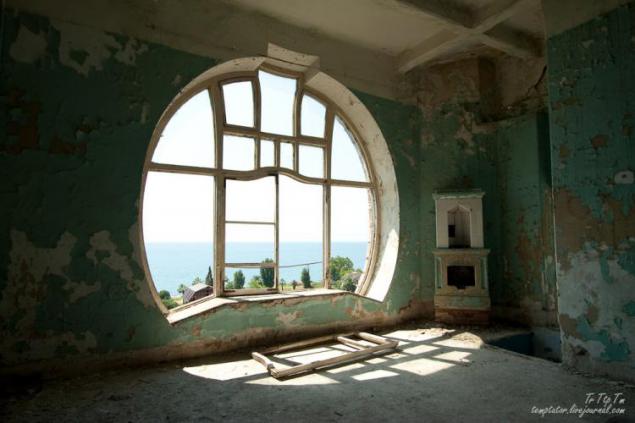
During the Georgian-Abkhaz conflict holiday house "The Seagull" was looted and then was not restored.


Balconies offer excellent views of the castle. Here, for example, the fortress Abaata:

Recovery requires too much investment, the Abkhaz say they do not have such funds, and investors discourages the absence of any guarantees from the Abkhaz authorities. And waiting to see what will come good uncle and will do nothing, but in the meantime, all decaying and falling apart more and more ...

Restaurant "Gagripsh" and wooden hotel was bought by Prince Oldenburg at an exhibition in Paris, delivered to Abkhazia unassembled - Austrian restaurant, hotel - from Norway and assembled already in place. Due to disrepair in the late 80s of the last century the hotel was dismantled. Restaurant "Gagripsh" looks nice from afar, slightly posharpan, if you get closer and, despite its status as one of the symbols of Gagra, has a disgusting kitchen.
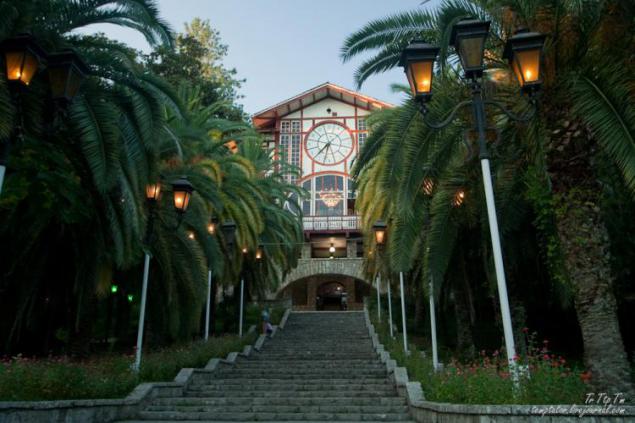
On the contrary "Gagripsh" - Seaside Park zdest broken in 1902-1905 years by the architect V. Shervinsky. Who looks poluzapuscheno - overgrown ponds, fountains sleepy ...

From Primortskogo park to an abandoned sanatorium "Rock" leads abandoned the same lift. Lower - yellow cabin more intact, top - red, they say, was blown up during the filming of a movie ...


Embankment near Seaside Park also in poor condition - all ragged and broken lights. Part of the beach, away from the sea that is overgrown with weeds.

Walking along the promenade always will enter to the colonnade and theater "Gagra».

If Colonnade renovated, the movie theater "Gagra" will get, apparently, soon. Sad lions on either side stairs, broken windows ...

Mountains of construction debris inside:

And yet amazingly preserved stucco on the ceiling of one of cinema:
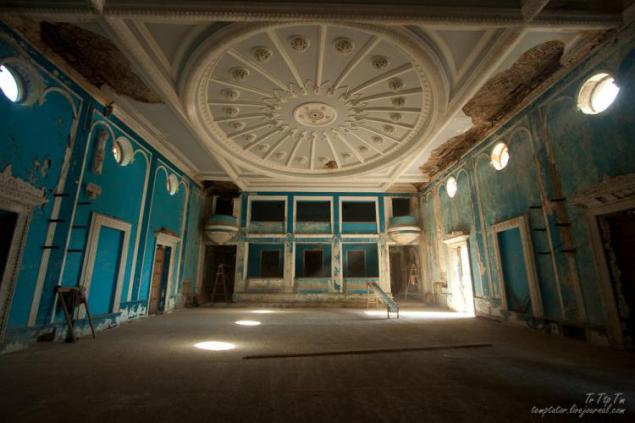
Boundary between two parts of the city - the Old and New Gagra is Tsiherva river. Near the gorge Tsihervy the railway station "Gagripsh", the former "Gagra - Pavilion". Railroad operates in Abkhazia, but terminals and stations abandoned without exception, "Gagripsh" - just one example of the devastation.

Nature gradually otvoёvyvaet ago a man his possessions. Platform under the bushes and grass is almost not visible.

Terraces station ivy and thorns.
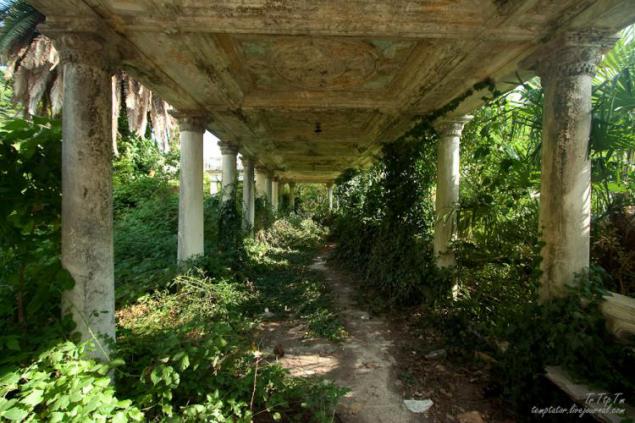
Yes, and the railway station in the state is very depressing. Although, they say, in comparison with other stations in Abkhazia, "Gagripsh" is more Versailles ...
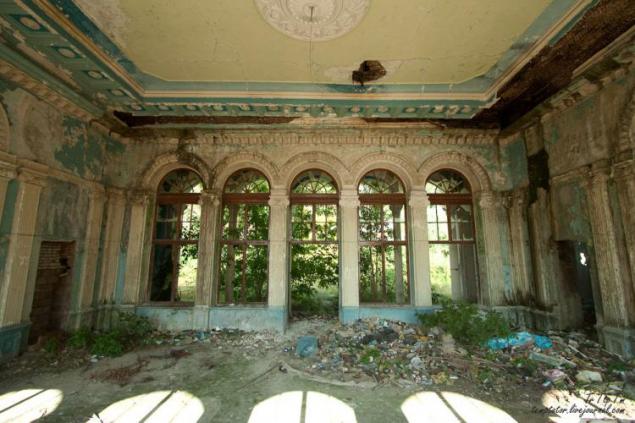
September 1st, I woke to the familiar melody from the first grade - "good books to read in school are taught in school are taught in school ..." It turned out that very close - Gagra school №2. Schools in Gagra, as it turned out, there are Abkhaz, Armenian and Russian. 2nd - Russian, but learning to children of all nationalities still mixed. School building №2 about 100 years. This former Cadet Corps. In the 60s of the last century, the building underwent repairs, after which he was only one peaked tower, the second domed observatory.

Rising slightly up from 2nd Street to School Circassian can enjoy some good views of the city. For example, the same 2nd School:

More climbing a little higher, we get on the road to the mountain Mamdzyshha that rises above the Gagra. On the way there are several viewing platforms, to the first - the lowest, can be reached on foot, the second and third observation is better to go on wheels. View from the lookout at the first New Gagra with her polunaselёnnymi dilapidated apartment blocks are not too impressive, so finally limit the view from the road in the direction of Old Gagra:

-
Author
Source

Abkhazian-Caucasian coloring manifested as soon as got into a taxi after the border. Kerf in the hollow volume of lezginka frayed wheezing speakers, the driver pulled up and, feels to have forgotten that there is a brake pedal. What is there to speak about overtaking through a continuous separating closed front for visibility turns, a real brave do not even think about such trifles as the oncoming traffic that can come from behind this turn right in the forehead ...
And then, finally, Gagra. Entrance to the city, decorated with a little depressing - abandoned shopping center.

The area in front of him - Gagarin Square fountain adorns inactive "Three Graces". A few days after the frame on the lawn around the fountain priberut trash, mow the grass and the bushes give a spherical shape.

Here he writes tourist guide "the Black Sea coast of the Caucasus" 1980 edition: "Gagra - one of the most beautiful resorts in the Black Sea coast. Pressed to the sea mountain range, it is situated on the shore of the bay mirror. Gopami protected from the cold continental winds and at the same time open by the warm sea, Gagra on its climate conditions - one of the best holiday destinations in the Soviet Union. This is the warmest and driest place on the Black Sea coast of the Caucasus. The average annual temperature is + 15, 2 degrees and rainfall is 1300 mm per year. Swim here begins in May and ends in late autumn, in November, when most of the country the mercury thermometer drops below zero, and in some places already raging snowstorm. The best time of the year - August, September, October. In these months, the temperature of the sea water varies from 18 to 28 degrees. »

Nature is without a doubt excellent. Mountains, clouds and catchy ranges down to the sea, coast, drowning in subtropical vegetation ... But the sad look on this background looted ruins ...
Right behind Piazza Gagarin, on the bridge, located an abandoned railway station Abaata. The station is named is located near the Abkhaz fortress built in the IV-V centuries. In those days the fortress is a powerful reinforcement. Abaata considered one of the oldest fortifications on the Black Sea coast. Now the fortress remained only a small fence, inside which is a small museum, temple, restaurant, hotel and boarding house abandoned "Zhoekvara" - photo in the header.



For station Abaata begins Zhoekvarskoe Gorge, climb to above which can be passing out Russian volunteers. There are several very battered apartment buildings, dilapidated building, reminiscent of DC and dozens of private houses.

Zhoekvarskoe Valley since time immemorial served as a road leading to the North Caucasus and binding Abkhaz and Circassian tribes. Abaata fortress, located near the mouth of the river Zhoekvara, in fact, covered this way.

Now Gorge - a great place for a walk on a hot afternoon. Only ten to fifteen minute walk and the road dives into the cool shade of boxwood trees. Cool shade, moss covering the trunks and shreds hanging from the branches - a real troll forest.


Just above the gorge on the river Zhoekvara there are several small picturesque waterfalls. You can get here on foot, but the road is gradually turning into a rather dirty and broken trail horse's hoof. We decided not to get dirty and ride on horseback to the waterfalls.


Settlement on the site of Gagra existed for a long time. In the II century before NE there was a Greek colony Triglia. In the beginning of our era Greeks were replaced by the Romans, who built a fortress here Nitika, the site of which was later built a fortress Abaata.
For the first time on the maps settlement appears at the beginning of the XIV century. In 1308 it under znazvaniem Kakar inflicted on his card Italian Pietro Visconti. In 1810, the Principality of Abkhazia became part of the Russian Empire, but the territory of Gagra was 20 years out of Russian influence. In 1830, the Russian garrison fortress occupies Abaata. These sites are then considered "the coffin for the Russian soldier." The fortress has been cut off from the outside world, malaria decimated the soldiers, were killed in large numbers and they are the bullets highlanders.
At the end of the XIX century these lands became eligible Athos monastery monks, but they beat a strong opponent - a relative of the king, Prince AP Oldenburg who wanted to organize a grand resort here. At the heart of the Prince of Oldenburg on development of Gagra was the desire to reduce the leakage of money that Russian know spender on foreign resorts, he wanted to create here "Russian Nice." Was founded Seaside Park, where excellent accustomed subtropical plants from different corners of the Earth, erected the building of the hotel and restaurant. The most grandiose construction became the Prince Castle, built in 1904.
Now the castle of the Prince of Oldenburg, as well as many other buildings in Gagra, produces a painful impression:

The castle was built by the architect IK Lyutseranskogo in modern style with a roof covered with red tiles. fireplace, balcony and tower Falconer - Prince was a lover of falconry. With the advent of the Soviet era, the castle was nationalized and placed it in a luxury holiday home of the Stalin "The Seagull».

During the Georgian-Abkhaz conflict holiday house "The Seagull" was looted and then was not restored.


Balconies offer excellent views of the castle. Here, for example, the fortress Abaata:

Recovery requires too much investment, the Abkhaz say they do not have such funds, and investors discourages the absence of any guarantees from the Abkhaz authorities. And waiting to see what will come good uncle and will do nothing, but in the meantime, all decaying and falling apart more and more ...

Restaurant "Gagripsh" and wooden hotel was bought by Prince Oldenburg at an exhibition in Paris, delivered to Abkhazia unassembled - Austrian restaurant, hotel - from Norway and assembled already in place. Due to disrepair in the late 80s of the last century the hotel was dismantled. Restaurant "Gagripsh" looks nice from afar, slightly posharpan, if you get closer and, despite its status as one of the symbols of Gagra, has a disgusting kitchen.

On the contrary "Gagripsh" - Seaside Park zdest broken in 1902-1905 years by the architect V. Shervinsky. Who looks poluzapuscheno - overgrown ponds, fountains sleepy ...

From Primortskogo park to an abandoned sanatorium "Rock" leads abandoned the same lift. Lower - yellow cabin more intact, top - red, they say, was blown up during the filming of a movie ...


Embankment near Seaside Park also in poor condition - all ragged and broken lights. Part of the beach, away from the sea that is overgrown with weeds.

Walking along the promenade always will enter to the colonnade and theater "Gagra».

If Colonnade renovated, the movie theater "Gagra" will get, apparently, soon. Sad lions on either side stairs, broken windows ...

Mountains of construction debris inside:

And yet amazingly preserved stucco on the ceiling of one of cinema:

Boundary between two parts of the city - the Old and New Gagra is Tsiherva river. Near the gorge Tsihervy the railway station "Gagripsh", the former "Gagra - Pavilion". Railroad operates in Abkhazia, but terminals and stations abandoned without exception, "Gagripsh" - just one example of the devastation.

Nature gradually otvoёvyvaet ago a man his possessions. Platform under the bushes and grass is almost not visible.

Terraces station ivy and thorns.

Yes, and the railway station in the state is very depressing. Although, they say, in comparison with other stations in Abkhazia, "Gagripsh" is more Versailles ...

September 1st, I woke to the familiar melody from the first grade - "good books to read in school are taught in school are taught in school ..." It turned out that very close - Gagra school №2. Schools in Gagra, as it turned out, there are Abkhaz, Armenian and Russian. 2nd - Russian, but learning to children of all nationalities still mixed. School building №2 about 100 years. This former Cadet Corps. In the 60s of the last century, the building underwent repairs, after which he was only one peaked tower, the second domed observatory.

Rising slightly up from 2nd Street to School Circassian can enjoy some good views of the city. For example, the same 2nd School:

More climbing a little higher, we get on the road to the mountain Mamdzyshha that rises above the Gagra. On the way there are several viewing platforms, to the first - the lowest, can be reached on foot, the second and third observation is better to go on wheels. View from the lookout at the first New Gagra with her polunaselёnnymi dilapidated apartment blocks are not too impressive, so finally limit the view from the road in the direction of Old Gagra:

-
Author
Source


